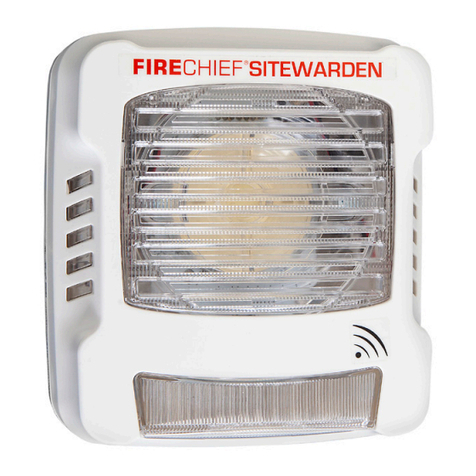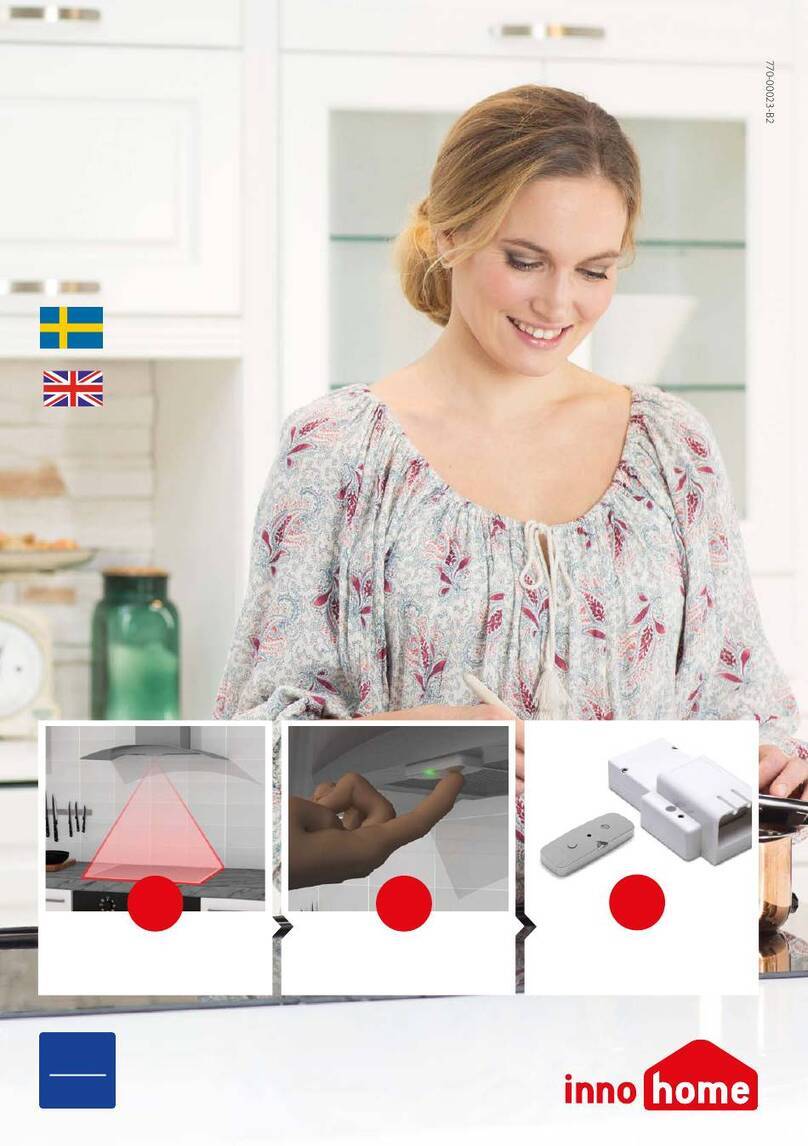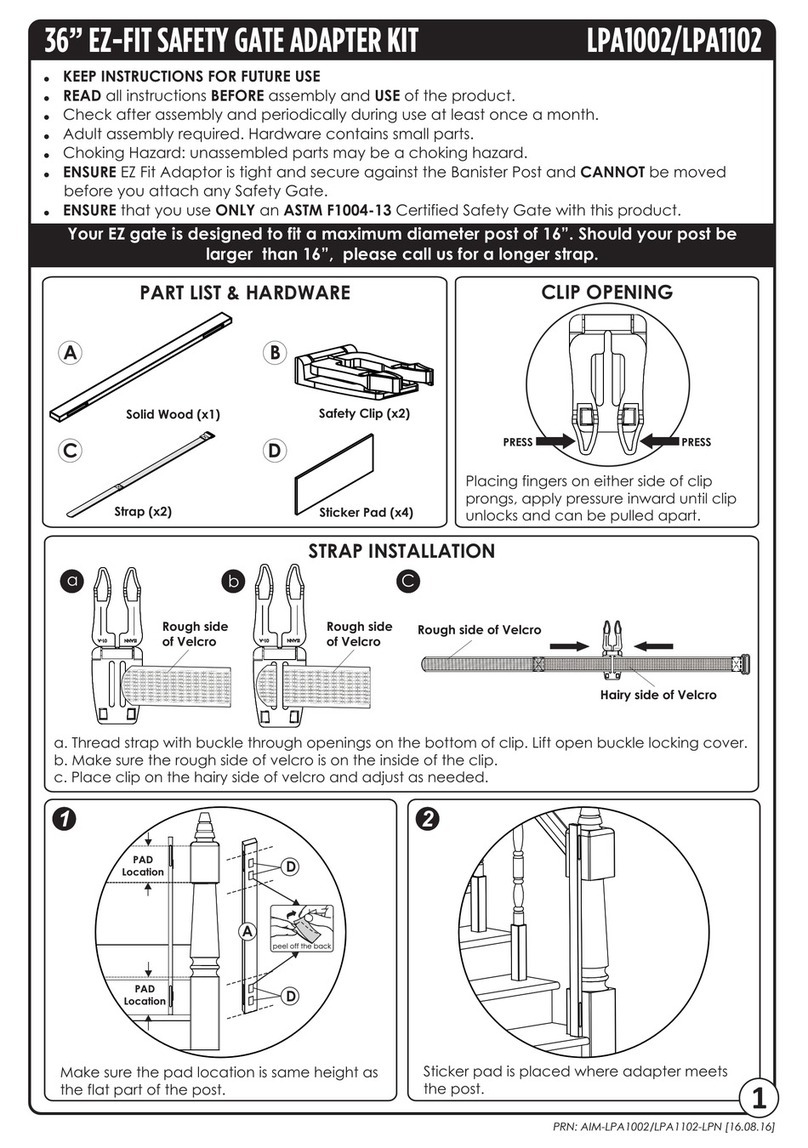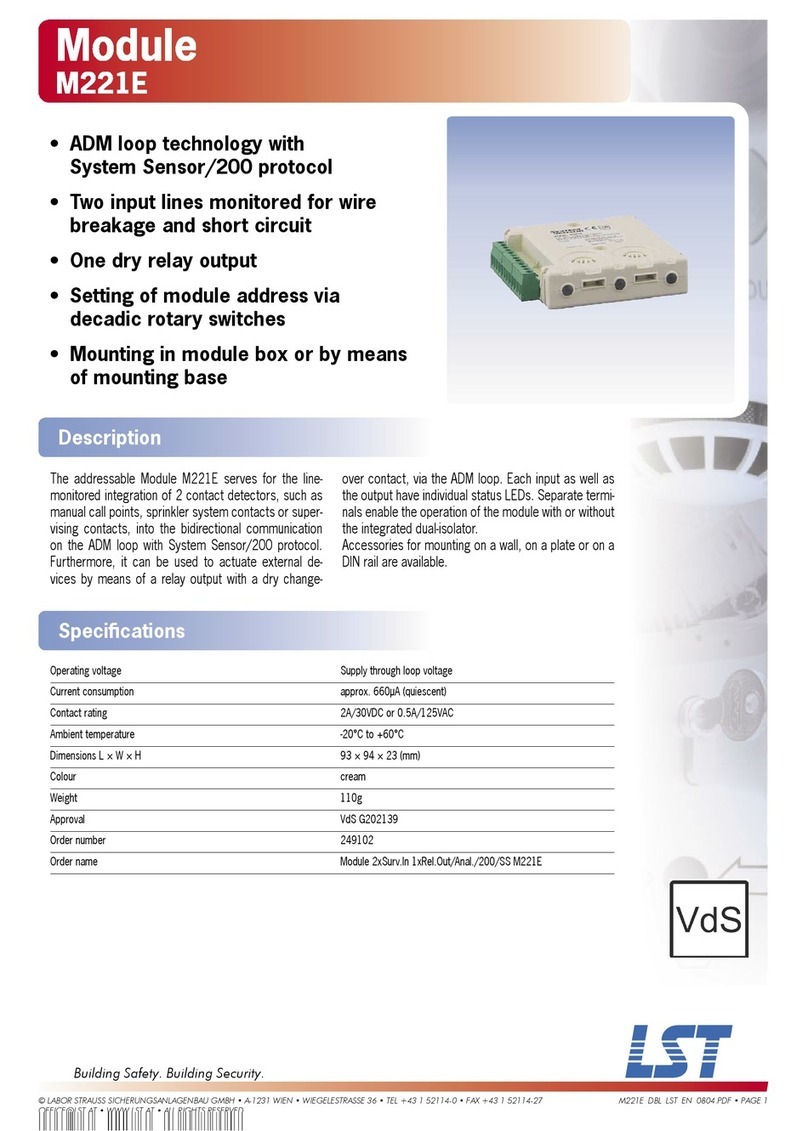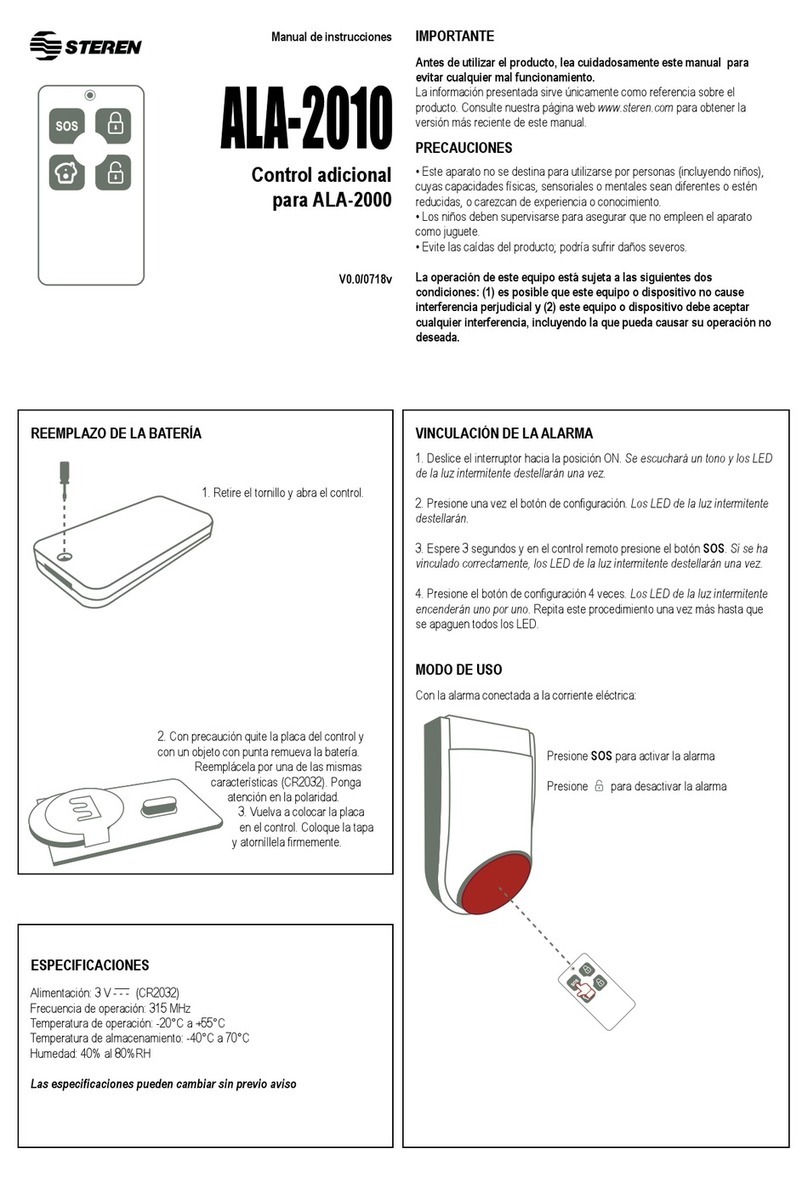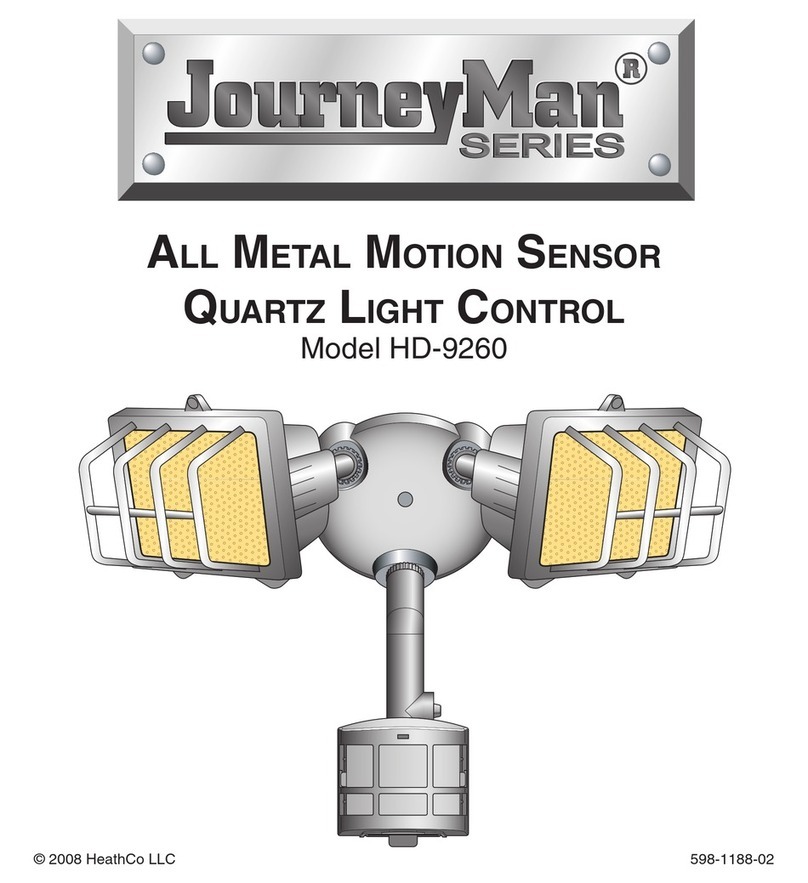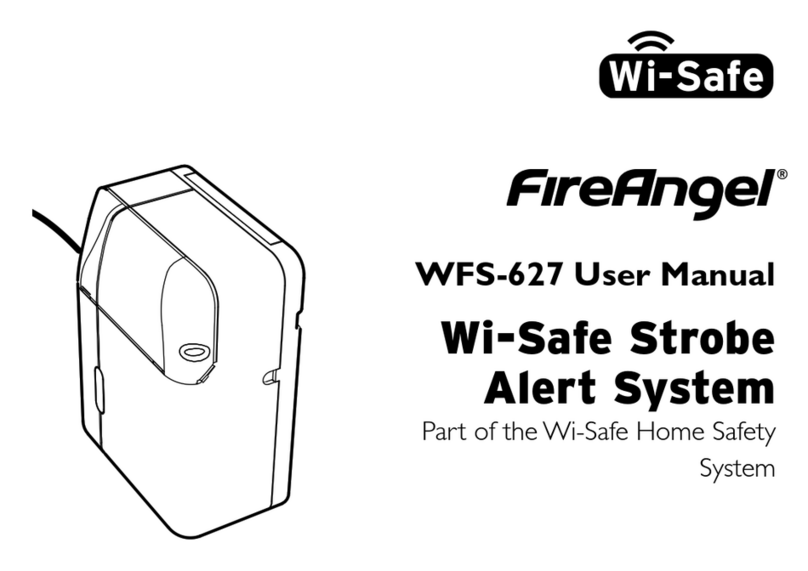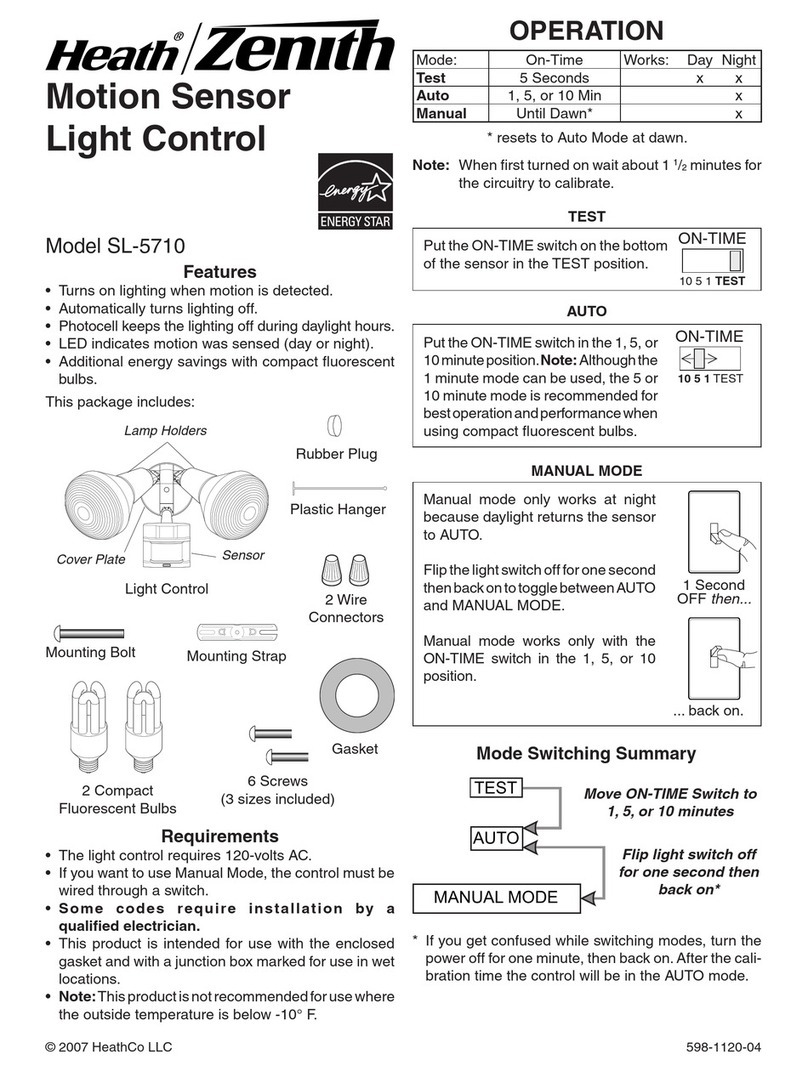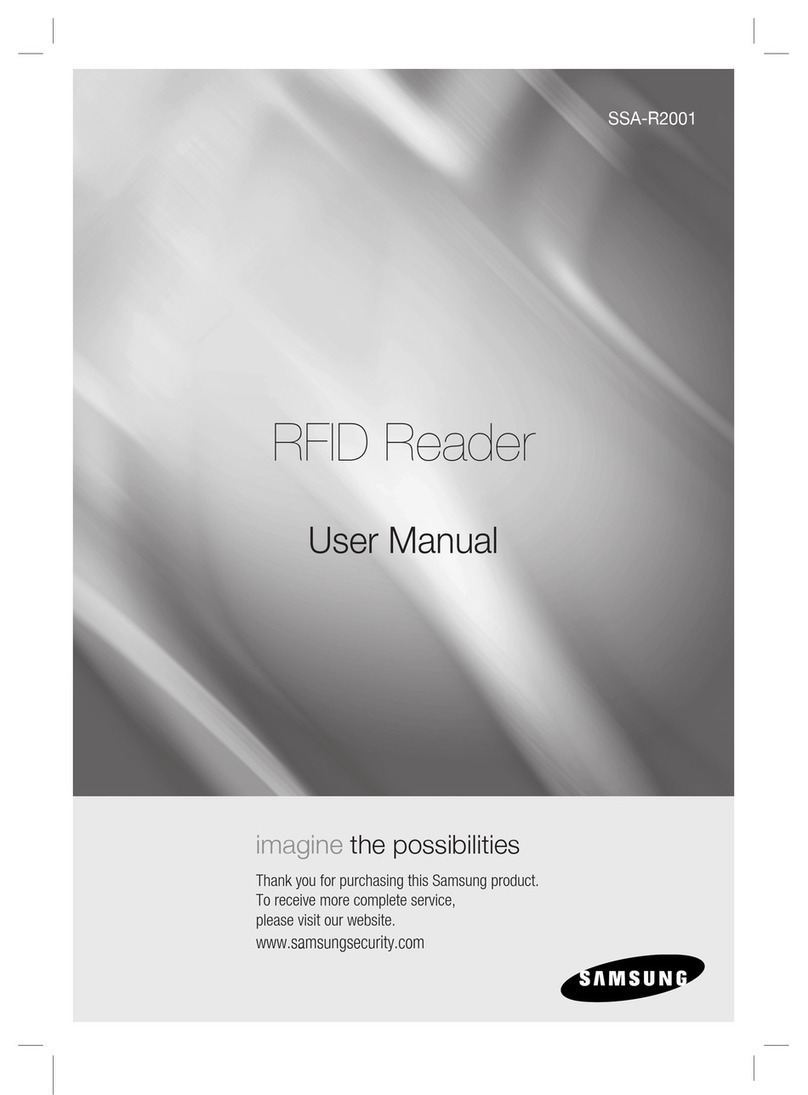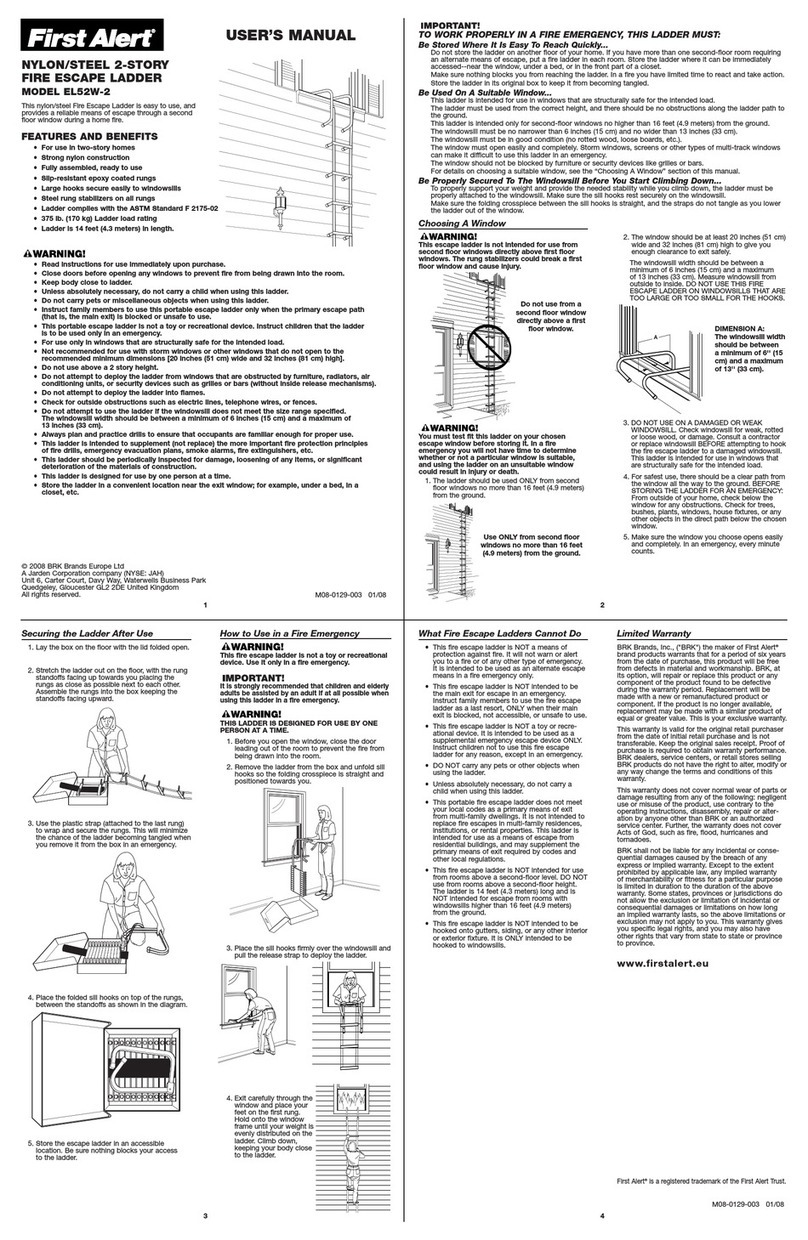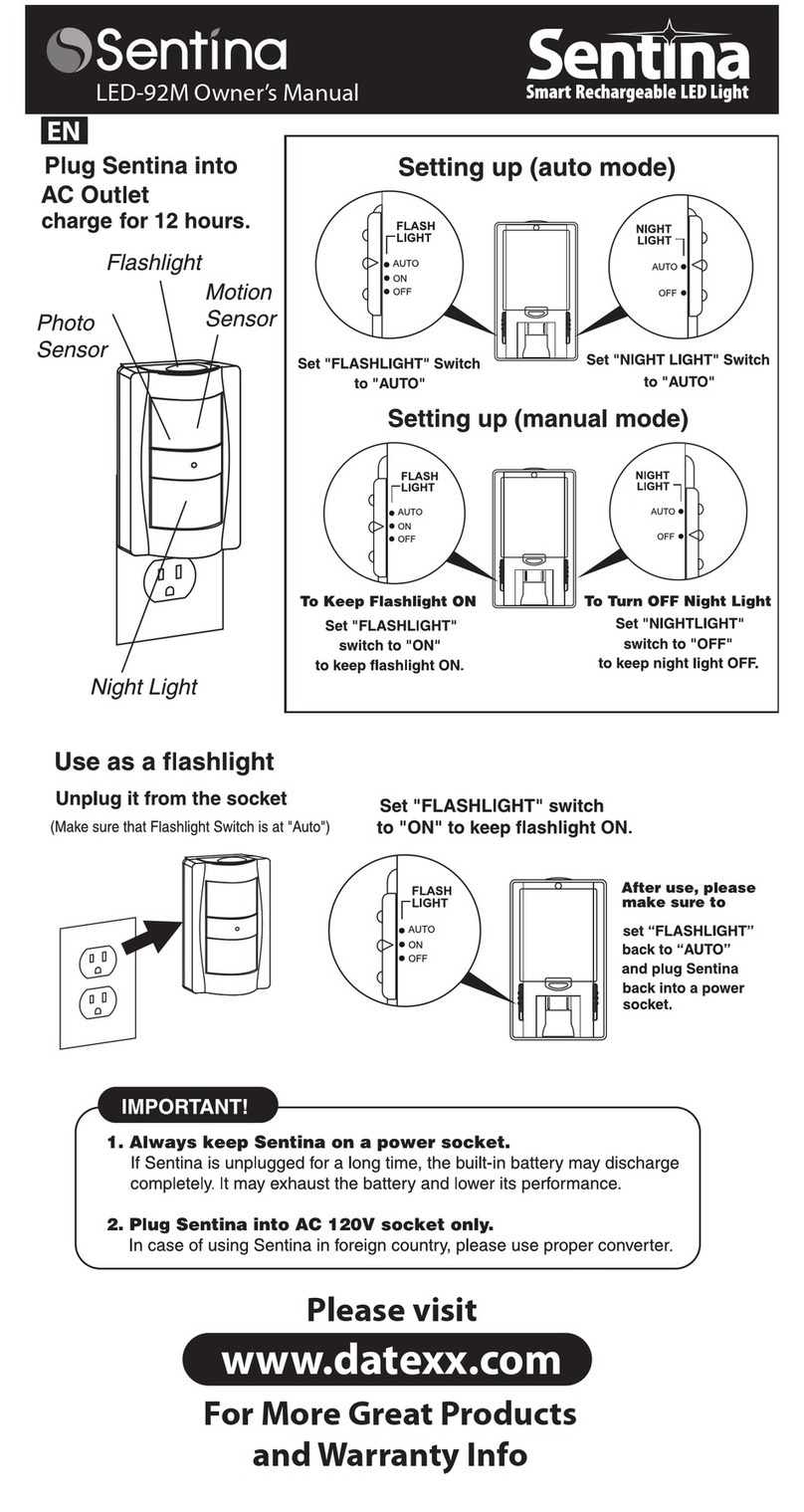Fire Chief Stove Guard SGS1010 Manual

INSTALLATION
& OPERATING
INSTRUCTIONS
Kitchen
STOVE
GUARD
FSG1

2
THANK YOU FOR CHOSING THE
FIRECHIEF KITCHEN STOVE GUARD
PACKAGE CONTENTS:
•Heat Sensor SGS1010
•Battery (CR2032)
•IR lens extension
•Control Unit SGC510-2
•Junction Box SGI510-2JF
• Main manual
• Cupboard sticker
•Screws
Firechief Stove Guard is a safety product for domestic kitchens.The Stove Guard consists of a
state-of-the-art Heat Sensor that monitors the cooker from above, and a Control Unit that cuts
the power to the cooker if a dangerous situation occurs.The Control Unit is installed behind
the cooker or inside a kitchen cabinet close to the cooker. Be sure to read this manual prior to
commencing installation.
SAFETY RULES
Firechief Stove Guard does not prevent all potentially dangerous situations, but it makes
the use of the cooker signicantly safer. Never leave the cooker unattended. Always check
compliance with local regulations.
• For indoor use only.
• Do not use in a professional kitchen.
• Do not hold the Heat Sensor close to the ear. It can cause
hearing damage when in alarm or test mode.
• Do not leave children alone with the product or any of its
parts or packaging.There is a risk of choking.
• Do not disassemble the product.
• Do not immerse the Heat Sensor in water.
• The Stove Guard will not emit an alarm if the temperature
of the cooker is too low to identify a dangerous situation,
or if the cooker has an automatic limitation of temperature
increase.
• The Stove Guard will not completely isolate the cooker. It
must never be used to turn off the cooker's power supply for
service/repair.
• Do not short-circuit, charge, open or heat the batteries.
There is a risk of explosion.
The operating instructions, accessories and stickers must accompany the product. Follow the safety guidance for safe
use of Stove Guard. If you have questions about the product, ask a specialist or refer to Firechiefglobal.com
2
SGC510-2
SGS1010
SG1510-2JF

3
CONTENTS
INSTALLATION 4–12
Installation of the Heat Sensor 5
Installation of the Control Unit 11
Function test 12
1
2
3
1a
Installation under
cooker hood
1bWall
mounting
1c
Ceiling
mounting
USER GUIDE 13–20
Getting started with Firechief Stove Guard 13
Read before using Firechief Stove Guard 14–15
Avoiding false alarms 14
After alarm: Cookers with mechanical controls 14
After alarm: Cookers with touch controls 14
Dislocation alarm 14
Action in the event of an alarm 15
Other settings 16–17
Changing the sensitivity level 16
Checking the sensitivity level 17
Resetting the Heat Sensor to factory settings 17
Pairing devices 17
Frequently asked questions 18–19
TECHNICAL SPECIFICATIONS 20
The Stove Guard 20
Cooker connection 21
Warranty 22
Disposal 22
EU Declaration of Conformity 22
RECOMMENDED
OPTIONAL
P.5-6 P. 7 - 8 P.9-10

1. INSTALLATION
4
INSTALLATION LOCATIONS
P. 6 -7 P. 8 - 9
INSTALLATION
INSTALLATION OF THE HEAT SENSOR
INSTALLING THE STOVE GUARD
Follow these instructions for correct installation.
STEP 1:
Installation of
the Heat Sensor
p. 4–10
STEP 2:
Installation of
the Control Unit
p. 11
STEP 3:
Function test
p. 12
The recommended place to install the Heat
Sensor is directly above the centre of the
cooker, under the cooker hood.The Heat
Sensor can also be mounted on a wall with
a mounting bracket or on the ceiling. Follow
these instructions for correct installation.
1a
Installation under cooker hood
1b Wall mounting
1c Ceiling mounting
RECOMMENDED OPTIONAL
Mounting bracket SAI1000-FBx
required for wall installations -
available separately.
For ceiling installations, the
supplied IR lens extension must
also be tted. See page 9.
Installation plate
with adhesive tape
Heat Sensor
Optional IR lens
extension (black)
1

INSTALLATION 5
1a
15cm
Zone 2 Zone 1
Radius 15 cm
Min 10 cm
Min 5 cm for
LED lamp
Zone 1 is immediately
above the middle of the
cooker plates. Max 15 cm
from the centre.
Zone 1
COOKER HOOD
Measure the installation height.The Heat Sensor should
be centred above the cooker, preferably within Zone 1
(see diagram at bottom of the page). It can be attached
to the grease lter. It is also important to ensure the
minimum distance from any lights underneath the hood
is 10 cm (5 cm is enough for LED lamp).
Please note: Zone 1 is recommended for best
performance.
1
Measure distance
SELECTING THE MOUNTING LOCATION
If there is a metal mesh grease lter on the cooker hood,
make sure it is free of grease and dry.
Carefully remove the protective lm from the installation
plate. Press for at least a minute while attaching installation
plate to allow adhesive to work.
2
MOUNTING THE INSTALLATION PLATE
Allow the Heat Sensor to reach room temperature before use.
The power to the cooker must be switched off (at the consumer unit).
See table on page 6 for the mounting location and follow instructions 1–4.

INSTALLATION UNDER COOKER HOOD
6
P. 6 -7
STARTING THE HEAT
SENSOR
Insert the battery and check step 4
before placing the Heat Sensor on the
installation plate.
Briey press the button. The
LED should ash green.
CHECK INSTALLATION HEIGHT
If the distance from cooker to Heat Sensor is more than 60 cm, the Heat
Sensor's sensitivity level must be adjusted manually.
Please refer to the table below together with the information on page 16.
Also watch the video on sensitivity conguration below.
3
* The installation may not in all cases meet all EN standard requirements.
See FAQ, page 18, point 4
Please note: the sensitivity level of the Heat Sensor is
conrmed by the appropriate sound pattern sequence
only (not LED ashes).
Watch the lm:
https://youtu.be/oy-hrT7nTQM
Setting the sensitivity level
4
Watch the lm:
https://youtu.be/SAeFdB3nP3s
Installation
DISTANCE FROM
COOKER TO
HEAT SENSOR
MOUNTING LOCATION SENSITIVITY LEVEL CONFIGURATION
0–60 cm
wide cooker 61–90 cm
wide cooker Sensitivity Acknowledgement "beep(s)"
81–100 cm Zone 1 & Zone 2 Zone 1 3 presses
76–80 cm
Zone 1
Zone 2*
Zone 1*
4 presses
71–75 cm 5 presses
65–70 cm 6 presses
61–64 cm 7 presses
45–60 cm Factory setting 8 presses

INSTALLATION 7
WALL 1b
SELECT THE REQUIRED LOCATION AND MOUNT THE BRACKET
Wall mounting requires a bracket (SAI1000-FBx), sold separately.The bracket can be fastened to
the wall using adhesive tape or screws.
See the detailed mounting instructions in the bracket package. Make sure that the bracket is
positioned correctly so that the Heat Sensor faces towards the centre of the cooker.
MOUNTING THE
INSTALLATION PLATE
Carefully remove the protective lm from
the installation plate. Press for at least a
minute while attaching installation plate to
allow adhesive to work.
1
Mounting height on the wall above the cooker
Max 90 cm wide cooker.
Recommended: 80 cm
Alternatively: 65–79 cm*
See mounting instructions provided separately with the bracket.
* For wall mounting with a distance less than 80 cm between the Heat Sensor and the cooker, the installation will not in all
cases meet all EN standard requirements.
3
2
80 cm
Allow the Heat Sensor to reach room temperature before use.
The power to the cooker must be switched off (at the consumer unit).
See table on page 8 for the mounting location and follow instructions 1–5.

8
WALL MOUNTING WITH BRACKET
P. 8 - 9
4 5
STARTING THE
HEAT SENSOR
Insert the battery and check step 5
before placing the Heat Sensor on
the installation plate.
Briey press the button. The LED
should ash green.
SET THE SENSITIVITY LEVEL
Set the Heat Sensor's sensitivity level according to the mounting height
(as described in the table below) by evenly pressing the Sensor's button.
The factory setting for the sensitivity level is 45–60 cm above the cooker.
Please refer to the table below together with the information on page 16.
Also watch the video on sensitivity conguration below.
DISTANCE FROM COOKER TO
HEAT SENSOR
SENSITIVITY LEVEL CONFIGURATION
Sensitivity Acknowledgement “beep(s)”
70–80 cm *3 presses
65–69 cm *4 presses
* 80cm recommended. For wall mounting with a distance less than
80cm between the Heat Sensor and the cooker, the installation may
not in all cases meet all EN standard requirements.
Please note: the sensitivity level of the Sensor is conrmed by
the appropriate sound pattern sequence only (not LED ashes).
Watch the lm:
https://youtu.be/oy-hrT7nTQM
Setting the sensitivity level
Watch the lm:
https://youtu.be/SAeFdB3nP3s
Installation

INSTALLATION 9
1c
CEILING
1REPLACE LENS
Carefully lift the lens with a screwdriver. Insert the IR lens
extension (included) as shown in the picture.The extension
should point directly upwards at an angle of 90°.
If the extension moves around, check that it has been
inserted the right way round.
2
Measure distance
FINDING THE MOUNTING POSITION
Measure the distance between the cooker and ceiling. Place
the Heat Sensor directly above the center point of the cooker.
Make sure that the surface is clean and dry.
MOUNTING THE INSTALLATION PLATE
Make sure that the ceiling is free of grease and dry.
Carefully remove the protective lm from the installation plate.
Press for at least a minute while attaching installation plate to
allow adhesive to work.
3
Allow the Heat Sensor to reach room temperature before use.
The power to the cooker must be switched off (at the consumer unit).
See table on page 10 for the mounting location and follow instructions 1–5.

10
CEILING MOUNTING WITH IR LENS
EXTENSION
P. 6 -7
45
STARTING THE HEAT
SENSOR
Insert the battery and check step 5
before placing the Heat Sensor on
the installation plate.
Briey press the button. The LED
should ash green.
SET SENSITIVITY LEVEL
Set the sensitivity level according to the mounting height (as described in
the table below) by evenly pressing the Sensor's button.The Heat Sensor's
sensitivity level must always be adjusted when installing it on the ceiling. Please
refer to the table below together with the information on page 16. Also
watch the video on sensitivity conguration below.
DISTANCE FROM COOKER TO HEAT SENSOR
SENSITIVITY LEVEL CONFIGURATION
Mounting height above
the cooker 0-90 cm wide cooker Sensitivity Number of "beep(s)"
160-200 cm Recommended: Immediately above the middle of the
cooker.
Alternatively: Farther out into the room with
bracket. See the bracket package for mounting
instructions.
1 press
2 presses
Mounting height above
the cooker 0-90 cm wide cooker
140-159 cm Recommended: Immediately above the middle of the
cooker.
Alternatively: Farther out into the room with
bracket. See the bracket package for mounting
instructions.
Please note: the sensitivity level of the Sensor is conrmed by the appropriate sound pattern sequence only (not LED ashes).
Watch the lm:
https://youtu.be/oy-hrT7nTQM
Setting the sensitivity level
Watch the lm:
https://youtu.be/SAeFdB3nP3s
Installation

INSTALLATION 11
CONTROL UNIT
It is a statutory requirement that the Junction Box is installed by an
authorized electrician. The power to the cooker must be disconnected
throughout the entire installation.
Disconnect the power
Switch off the power at the
consumer unit.
Note! Do not turn on the
Consumer unit before the Heat
Sensor is set up and ready for a
function test.
Connecting the Junction Box
For correct installation of the Junction Box, ensure to refer to the wiring
diagram on page 21.The Control Unit will then plug & play into the
Junction Box
2
Watch the lm:
https://youtu.be/s7ato2xYQUY
Test alarm
1
POWER
OFF

12
P. 6 -7 P. 8 - 9
FUNCTION TEST
The installation is completed when the function test has been passed. The Heat Sensor
will then give an alarm in a dangerous situation. The user manual, accessories and stickers
should be stored close to the Stove Guard for future reference.
Return the power
Switch on the power at the
consumer unit.
Perform function test
Wait 30 seconds after switching
on the power. Press and hold the
button until the Heat Sensor emits
a “beep” ( ) and the red LED
ashes. Release the button.
The Control Unit will switch off
the cooker and give an alarm
signal every 5 seconds.The Heat
Sensor will also emit a test alarm
after a few seconds.
Note! Ensure that there is no
power going to any of the cooking
plates.
Reset the alarm
It is important to reset the alarm
after a function test to return
power to the cooker. Reset the
test alarm by pressing the button
once.
Check that the cooker can be
turned on (or that there is
voltage in the Control Unit).
If the Heat Sensor does not
respond or if the test alarm
cannot be reset, see page 18,
points 5 and 6.
1 2 3
Installation is now ready.
When connecting the Stove Guard for the rst time it is recommended to wait 15 minutes before normal
cooker use to allow the Stove Guard to perform nal system checks.
POWER
ON

USER GUIDE 13
P. 6 -7 P. 8 - 9
USER GUIDE
GETTING STARTED
The installation is completed when the function test has been passed.
The Heat Sensor will then give an alarm in a dangerous situation. The user manual,
accessories and stickers should be stored close to the Stove Guard for future reference.
After installation, the Heat Sensor
may start making short “beeps”
every ve seconds while the stove is
being used (“pre-alarm”).
If there is not a dangerous situation,
press the button to indicate that the
situation is safe.
The Heat Sensor has then learned
more about your cooking habits
and you can continue cooking.
Please note:
When installing the Heat Sensor on the ceiling, the learning function will not be operational.The Heat Sensor
will automatically sound and switch the cooker off in the event of an increased heat condition.
The Heat Sensor learns and adjusts, when the user resets the pre-alarm. See FAQ page 19, point 14.
In order to reset the system, turn all controls off. The Stove Guard will automatically reset itself after the heat
condition has cleared and the cooker has cooled down.
2

14
AVOIDING FALSE ALARMS
Be sure to use a pan that covers the entire hotplate to prevent false alarms. Also, using a lid is recommended.
Always use the cooker hood to extract fumes if you have one.
If you have a freestanding cooker or an oven under the hob, the oven controls will also be turned off once the power
supply to the cooker or hob has been switched off by the alarm.
AFTER ALARM
Mechanical controls
If the Stove Guard has turned the cooker off, rst turn all cooker controls to ‘0’, then press the Heat Sensor button
once.After this, the cooker can be used normally.With ceiling installation, the reset button needs to be pressed to
return the power.
Touch controls
If the Stove Guard has turned the cooker off, press the Heat Sensor button once.After this, the cooker can be used
normally.
In some cases you must wait until the cooker has cooled down to continue to use.
DISLOCATION ALARM
Removing the Heat Sensor from the installation plate cuts off the power to the cooker. Returning the
Sensor back to the installation plate returns the power to the cooker. Press the Heat Sensor button once.

USER GUIDE 15
ACTION IN THE EVENT OF AN ALARM
P. 6 -7 P. 8 - 9
The cooker will automatically be ready for use after the Stove Guard has detected that the
hazardous situation is over, and all the controls are set to “0”.
See the alarm overview below for actions.
SOUND MEANING MEASURES
Heat Sensor
4 “beeps” with a 1-second interval.
Dislocation Alarm
The Heat Sensor is removed
from the installation plate.
Return the Heat Sensor to the installation plate with the LED facing
the user.
Heat Sensor
Short “beeps” with
5-second intervals.
...
Pre-Alarm
The Heat Sensor sounds an
alert to warn user of danger
before
disconnecting the cooker.
If the pre-alarm is triggered during normal cooking: press the Heat
Sensor button once while the pre-alarm sounds.The alarm will be
turned off and the sensitivity adjusts slightly, to suit your cooking style.
Heat Sensor
Many quick “beeps” followed by a
long, very loud sound.
... !!!!
Switch-off Alarm
The cooker is switched off.
Make sure that the controls are set to “0”. Press the Heat Sensor
button once to return the power to the cooker.
Control Unit
Short “ring” with 5-second
intervals.
No power
The power to the
cooker has been cut off.
Make sure that the controls are set to "0".Wait until the cooker has
cooled down after it has been disconnected then press the Heat Sen-
sor button once to return the power. If the cooker cannot be switched
back on, see FAQ, question 9, page 19.
Control Unit
Continuous "rings".
No power
The cooker is too hot for the
power to be turned back on.
Make sure that the controls are set to "0".Wait until the cooker has
cooled down and the Control Unit starts emitting a short "ring" with
5-second intervals as described in the section above, or press the Heat
Sensor button once to reconnect the cooker. If the alarm does not stop,
follow the instructions on page 19, FAQ question 9, and press again.
Control Unit
Short and long “ring” with 10-sec-
ond intervals.
No power due to
Auto-diagnostics Alarm
The cooker has been discon-
nected due to a temporary fault
(automatic error diagnosis).
Make sure that the controls are set to "0".Wait until the cooker has
cooled down after it has been disconnected then press the Heat Sen-
sor button once to return the power. If the cooker cannot be switched
back on, see FAQ, question 3, page 18.
Heat Sensor
One “beep” per minute.
Or
Control Unit
One “ring” per minute.
Battery Alarm
The Heat Sensor has a low
battery.
The Heat Sensor battery is low and needs to be replaced. Pressing the
button once at this time delays the alarm for at least 12 hours.

16
CHANGE THE SENSITIVITY LEVEL
OTHER SETTINGS
Due to differences in kitchen environments, the sensitivity level of the
Heat Sensor may have to be adjusted manually.
1. Remove the Sensor from the installation plate
The Heat Sensor emits 4 “beeps” ( ).The cooker is turned off.
2. Adjust the sensitivity level
See pages 6-10 for sensivitity levels to be applied.
Place the Heat Sensor on the table (as shown in the picture). Press and hold in the button until 2 “beeps” ( ) are
heard. Release the button.The correct sensitivity can now be input.
Note! When selecting the correct sensitivity level it is important the process is not rushed. Ensure the sensor button
is pressed down rmly each time, holding for 1 second before releasing.
Be sure to pause for 1 second between each press.
3. Conrmation of setting
After 5-15 seconds, the Heat Sensor will conrm the sensitivity setting with the same number of “beeps”.
In case of error, start from step 2 again. Please note that the sensitivity level is conrmed by the appropriate number of
"beeps" only and not LED ashes.
4. Activate the Sensor
Return the Heat Sensor correctly onto the installation plate. Press the button once.
Watch the lm:
https://youtu.be/oy-hrT7nTQM
Setting the sensitivity level
“BEEP” .... “BEEP”

USER GUIDE 17
P. 8 - 9
CHECKING THE
SENSITIVITY LEVEL
1. Remove the Sensor from the
installation plate. (The Sensor gives
4 “beeps” ( ) and the cooker
is switched off.)
2. Press and hold the button (ap-
prox. 10 sec.) until 2 “beeps”
( ) are heard.
3. An unadjusted Sensor’s sensitivity
setting is level 8, and when checking
the level, the Sensor gives a set of
“beeps” as follows: 8 - 8 - 5 - 8. If
the sensitivity was adjusted to level
4, the sensor would give “beeps”:
4 - 4 - 5 - 4.
RESET THE HEAT
SENSOR TO FACTORY
SETTINGS
Remove the Sensor from the
installation plate. (The Sensor gives
4 “beeps” ( ) power is cut
off to the cooker).
1. Remove the battery lid.
2. Press the button once.
3. Return the battery lid.The Heat
Sensor shall make a "beep".
4. Press and hold the button until
the three "beeps" are heard. Re-
lease.
If three "beeps" cannot be heard,
something went wrong. Repeat
from Step 1. Return the Heat
Sensor to its installation plate and
press the button once.
“BEEP”“BEEP” “BEEP”
123
4
“BEEP”“BEEP”
Watch the lm:
https://youtu.be/aV6Cl7x9mJY
Checking sensitivity level
Watch the lm:
https://youtu.be/uJ4T_gMJApQ
Reset to factory settings
PAIRING DEVICES
The units are already paired at the factory. When replacing the Heat
Sensor or the Control Unit, the devices must be paired again.
Note! The Heat Sensor must be
placed on the installation plate
during pairing.
1. Check that the cooker is
connected to the power
supply.
2. Press and hold the reset
button rmly for 20 seconds.
The Control Unit will emit
two sets of clicks and buzzes
(approximately after 5 and 20
seconds). Release the reset
button after the second set of
clicks and buzzes.The Control
Unit is now ready to be paired.
3. Press and hold the NEW Heat
Sensor button until it emits
a “beep” ( ) and a red LED
ashes. The Control Unit makes
a buzzing sound and the Heat
Sensor emits a “beep” ( ).
4. After 5 seconds, the Heat
Sensor gives an alarm (rst
one "beep" and after a while
continuous beeping).The Control
Unit and the Heat Sensor are
now successfully paired.
5. Reset the test alarm by pressing
shortly the Heat Sensor button.
Check that the cooker can be
turned on. If the Heat Sensor
does not respond or if the test
alarm cannot be reset, see FAQ,
page 18, points 5 and 6.
Reset
button

18
FREQUENTLY ASKED QUESTIONS
1. I cannot turn on the cooker, and there is no signal
from the Control Unit
ANSWER 1: The Heat Sensor has been removed or
placed
incorrectly on the installation plate.The Heat
Sensor should be positioned parallel to the installation
plate and it is recommended to have the LED facing the
user.
ANSWER 2: If the Heat Sensor is correctly positioned
on the installation plate, the Control Unit’s overheating
protection has switched the cooker’s power off. The
cooker can be switched on again by turning off the
power supply for a few seconds using the cooker’s fuse
(in the consumer unit). If the overheating protection
fails again, move the Control Unit to a cooler or better-
ventilated place.
2. The Stove Guard emits alarms during normal
cooking
ANSWER 1: If the Heat Sensor is positioned lower
than 90 cm above the cooker, it has a learning function
(see page 13). Pressing the Heat Sensor button during
the pre-alarm lowers the sensitivity slightly.
Other causes of alarms during normal cooking:
•A pot is removed from a hot hotplate
• A kettle/pot does not cover the hotplate
• Cooking without a lid
• A hot frying pan placed on the hotplate
ANSWER 2: If measures to prevent unnecessary alarms
have been performed a few times and the Heat Sensor
still emits alarms in the same situation, the sensitivity
should be adjusted less sensitive manually, for example
from level 4 to level 5. See page 16.
3. The Auto-diagnostics alarm was not reset by
pressing the Heat Sensor button once
ANSWER 1: The Auto-diagnostics alarm (Control
Unit emits one short and one long "ring" every ten
seconds) may be triggered if the Heat Sensor is not on
the installation plate, if it is positioned incorrectly, or if it
is covered by dirt or grease. It can also be triggered by a
problem with the radio connection or malfunction of the
Control Unit.
ANSWER 2: Make sure that the Heat Sensor is rmly
attached to the installation plate and that it is positioned
correctly.The LED should be facing the user (see page 5).
Clean the Heat Sensor with a lint-free cloth moistened
with soapy water.
Press the Heat Sensor button once.
ANSWER 3: Turn off the cooker’s power from the
consumer unit for 15 seconds.
ANSWER 4: If the fault diagnosis switches off the
cooker again, contact the retailer. If the cooker is still
turned off due to the fault diagnosis, it can only be
used for 5 minutes at a time by turning the power off
for 15 seconds as described in answer 2 above (EN
requirements).
4. Placing of the Heat Sensor in zones that do not
necessarily match all EN standard requirements
ANSWER: According to the EN standard, the Heat
Sensor should "see" the base of the pot in order to
measure the temperature. In these zones (see the
tables on pages 5, 7 and 9), the Heat Sensor cannot see
the bottom
of pots with high edges and may identify a
hazardous
situation somewhat more slowly, but is still
safe to use.
5. During the function test, the Heat Sensor does
not emit a sound when the button is pressed
ANSWER: Make sure that the battery has power and
is inserted properly, "plus-side" up.
6. The test alarm cannot be reset
ANSWER: First try the function test, see page 12. If this
does not x the problem, turn off the cooker’s power
at the consumer unit for 15 seconds and repeat the
function test.Wait for 5 seconds before resetting the
alarm.
7. The Stove Guard did not give an alarm in a
dangerous situation

FREQUENTLY ASKED QUESTIONS 19
ANSWER: It is possible that the temperature was not
high enough to be identied as a dangerous situation.
The Heat Sensor takes different cooking situations into
account, including high-temperature cooking, and should
not give an alarm too easily.Therefore, the Stove Guard
only emits an alarm when a certain temperature (or rate
of temperature rise) is detected, but still long before a
real risk situation. However, it is important to check the
Stove Guard’s function (see the next sections).
• Make sure that the Heat Sensor is correctly installed.
See page 5 and after.
• If the Heat Sensor is properly installed, turn on a
hotplate and perform a function test, see page 12.
Make sure the Control Unit turns off the cooker. If the
function test fails, contact the retailer.
• When mounting lower than 90 cm above the cooker,
it is possible to change the sensitivity of the Heat Sensor,
so it reacts earlier. Increase the sensitivity by one or two
steps. See page 14.
8. I cancelled the pre-alarm by mistake, even though
the alarm was triggered by a dangerous situation.
Has the Heat Sensor become too insensitive now?
ANSWER: Deactivating the pre-alarm changes the
sensitivity, but only to a small extent.This can
therefore be carried out a few times without the alarm
becoming insensitive.
9. I cannot turn on the cooker and the Control Unit
emits a ring tone almost continuously
ANSWER: The cooker is locked due to several
repeated alarms for the maximum temperature. Unlock
by turning off the cooker's power at the
consumer unit for 15 seconds.
10. How do you test Stove Guard with an
induction cooker?
ANSWER: You need an adapter plate that allows
the use of all cookware on an induction cooker
(available from many retailers) or an induction suitable
cooking vessel. Place the adapter plate on a cooker
and perform a heat test by turning on the plate.This
test is not absolutely necessary, as potential problems
are eventually solved by the Auto-diagnostics.
Note! The test is recommended when retrotting the
cooker and ceiling-mounted Heat Sensor.
11. The Heat Sensor gives an alarm when I make
coffee with an espresso pot
Espresso pots are often much smaller than the hotplate,
and the heat from the plate makes the Stove Guard think
there is a dangerous situation. Use suitable sized cooking
vessels.
ANSWER: Deactivate the alarm by pressing the Heat
Sensor button.The sensitivity level of the Heat Sensor
will not adapt automatically, as the espresso maker
triggered an alarm for maximum temperature and
therefore self-learning will not take place.
12. What do I do if the Heat Sensor or the Control
Unit must be replaced with a new one?
ANSWER: Contact the retailer for a new part.When
replacing, pair the devices. See page 15.
13. Where can I nd the Heat Sensor model
number?
ANSWER: On the underside of the Heat Sensor there
is a sticker with the model number.
14. Why does the learning sensitivity function not
work when I install the Heat Sensor on the ceiling?
ANSWER: The Heat Sensor "learns" based on the
frequency of manually reset pre-alarms.
The Heat Sensor's ability to automatically return the
power to the cooker after an event enables the user
to not have to reset the alarm manually (by using an
additional reset button or reaching to the ceiling to press
the button of the Heat Sensor).The Heat Sensor will not
learn and adjust its sensitivity level because there are no
manual reset requirements for pre-alarms when on the
ceiling.

20
TECHNICAL SPECIFICATIONS
IR lens
(Lens extension for
high installations)
Button
Battery lid
(Battery 1 x CR2032)
Signal LED
should face towards use
• Voltage 230–400 VAC
• Extremely low energy
use (approx. 1 W)
• Automatic electrical
switch
• For safe connections
up to 10 mm2
wires
• Alarm signal 80 dB(A) @ 1 m • RF 433 MHz • Patented EP1861839, EP2902710
• Fulls EN 50615:2015 Standard for stove guards (Eurons Expert Services Oy)
THE HEAT SENSOR
THE CONTROL UNIT THE JUNCTION BOX
3
This manual suits for next models
3
Table of contents
Other Fire Chief Home Safety Product manuals
